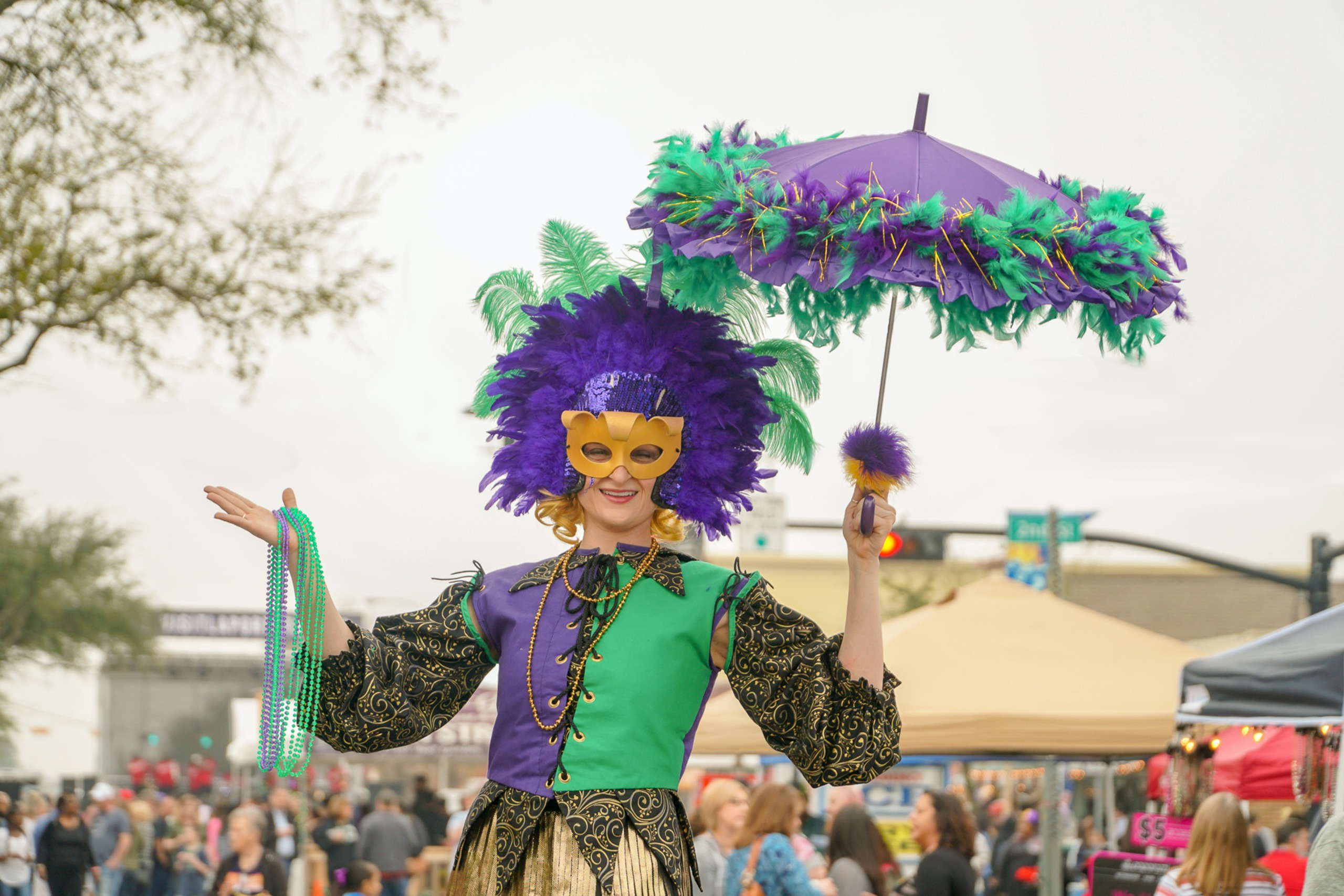There’s no party like a Mardi Party! The most predominant celebration of Mardi Gras has arrived and partygoers across the country are breaking out their beads, boas and most extravagant styles. Mardi Gras celebrations are for the end of the Carnival season, which represents the time between Christmas and Lent, and calls for eating, drinking, and partying. Mardi Gras is a French term, translating literally to “Fat Tuesday” in English. Elaborately decorated floats, unique masks, and fanciful wardrobes parade through town in city-wide annual celebrations lasting multiple days up through Fat Tuesday.
Let’s take a look at the history of Mardi Gras. The original Mardi Gras celebrations date back to medieval Europe in the 17th and 18th centuries, though it was first celebrated in the United States in 1703. A surprise to some, the first state-side Mardi Gras was actually hosted in Mobile, Alabama, not New Orleans, Louisiana. It all started when French-Canadian explorer, Jean Baptiste Le Moyne Sieur de Bienville, arrived in America and established “Fort Louis de la Louisiane” in Mobile. New Orleans was later established in 1718, and Mardi Gras celebrations began there in the 1730s.
In the mid-1800s, Mardi Gras became closer to what it is today with street processions, floats, and masked balls. In 1872, the first King of Carnival was crowned to reign over the first daytime parade. This was also the year that purple, green, and gold were founded as the official Mardi Gras colors. Purple stands for justice, green for faith, and gold for power. Three years later, the Louisiana governor signed the “Mardi Gras Act” making Fat Tuesday, the day before Ash Wednesday, a legal holiday in the state.
If you’re looking to celebrate at home, the King Cake tradition is a sweet way to celebrate Mardi Gras season. The ring-shaped cake is decorated with purple, green, and gold icing and sprinkles. Each King Cake is baked with a tiny plastic baby inside and the person who finds the baby in their piece of cake is said to be lucky. However, they are also tasked with bringing the King Cake to the party next year!
From the de facto home of Mardi Gras in New Orleans, Louisiana, to the de jure originator, Mobile, Alabama, and St. Louis, Missouri, check out some of our favorite festive destinations across the country.

New Orleans, LA
January 6 marks the official end of the Christmas season and kicks off Carnival in New Orleans. Parades, balls, and festive events lead the celebration up to Mardi Gras. Technically, Mardi Gras is the day before Ash Wednesday, though it is often referred to as the month-long celebration. This year it falls on Tuesday, February 21.
Another prominent New Orleans Mardi Gras tradition outside the street parades is extravagant balls. The balls are thrown by the King and Queen of each krewe, an exclusive Carnival celebration club, on the night of their parade. The black-tie affairs include entertainment, music, food, drinks, and merriment.
If you’re heading to New Orleans for Mardi Gras, be prepared to catch some beads. Krewe members riding the floats toss trinkets, toys, cups, and of course, colorful beads, into the audience. Krewe members are dressed in full costume, including masks covering their eyes or full face, so their identity is concealed. Grabbing the beads and throws tends to become a competition, and your neck may be sore by the end of the day!
Mardi Gras parades have been happening since January 6, though the primary Krewe parades are upcoming. To view the full schedule and parade routes, see here. The unique floats are what make the parades so special, and they have played a role in Mardi Gras history for over 100 years. The intricately designed floats usually fall within two different styles: exquisitely beautiful and humorous. The floats are created to reflect the theme of the krewe riding on them. The multi-thousand-dollar creations are designed and decorated year-round.
If you’re heading to New Orleans for the action, be sure to plan your transportation in advance. The city is overflowing with people and the traffic can be intense. The French Quarter is closed during Mardi Gras weekend, and only hotel guests staying in the Quarter are allowed to drive through. There are off-site lots available, but they are known to fill up quickly. Monitor the rideshare and taxi pricing because they are known to surge during Mardi Gras weekend.
If you do find yourself driving around New Orleans, beyond the French Quarter, ParkMobile is available throughout town. Plan ahead and monitor for traffic and closed routes. ParkMobile allows you to pay for parking right from your mobile device, allowing you to carry even less to the parades.
Mobile, AL
While many think New Orleans is the birthplace of Mardi Gras, it’s actually Mobile, Alabama. The city’s first Mardi Gras was in 1703, with the first masked ball in 1704, and the first parade in 1711. Today, the city is known for its family-friendly celebrations that continue for two weeks prior to Fat Tuesday. Schools in Mobile actually close for the final Monday and Tuesday of Mardi Gras season.
 Mobile hosts parades every day for the two weeks leading up to Fat Tuesday, with multiple, bigger parades on Fridays, Saturdays, and Sundays. The parade routes go through downtown Mobile so parade-goers can watch from anywhere. Most people have a favorite square or street corner they return to each year. Bars, restaurants, and hotels throughout downtown have street-facing balconies, similar to the French Quarter in New Orleans, to watch the parades from inside or to host private parties of their own.
Mobile hosts parades every day for the two weeks leading up to Fat Tuesday, with multiple, bigger parades on Fridays, Saturdays, and Sundays. The parade routes go through downtown Mobile so parade-goers can watch from anywhere. Most people have a favorite square or street corner they return to each year. Bars, restaurants, and hotels throughout downtown have street-facing balconies, similar to the French Quarter in New Orleans, to watch the parades from inside or to host private parties of their own.
Each parade is followed by a Mardi Gras Ball, complete with a King and Queen of the ball. Each organization hosting the ball, votes yearly on the King and Queen and themes of the parade and floats, which are a surprise until revealed during the Mardi Gras season. The organizations hold charity events throughout the year. Some organizations are more historical and unique than others, the older ones called krewes, with traditions that can be traced back to the very first balls of Mobile.
Mobile Mardi Gras also consists of items tossed from the floats: stuffed animals, coins, beads, Moon Pies, roses. It’s like Halloween all over again – bring a bag to take the goodies home with you!
Find Mardi Gras parking with ParkMobile in Mobile here and laissez les bons temps rouler!
St. Louis, MO
St. Louis is home to one of the nation’s largest Mardi Gras celebrations in the city’s “Soulard” neighborhood. From now through February 21, Soulard Mardi Gras is the most popular party in town. Various events lead up to the big event, the Bud Light Grand Mardi Gras Parade on February 18, including a cajun cook-off, 5K, scavenger hunt, pet parade, and wiener dog derby.
The Bug Light Grand Parade is Soulard’s annual ode to the Big Easy Mardi Gras celebrations and is the biggest parade outside of New Orleans. The free event starts at Busch Stadium and continues through South and Soulard, ending at the Anheuser-Busch Brewery.
The party doesn’t stop after the parade–the Rue du Cirque is a post-parade street party with the world’s largest game of flip cup. In 2022, the game made history with 816 competitors.
If you’re visiting St. Louis for the festivities, bring ParkMobile along with you. We’re available around the city to make parking a seamless experience.

 Get it on Google Play
Get it on Google Play